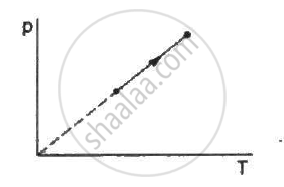Advertisements
Advertisements
Question
At what temperature the mean speed of the molecules of hydrogen gas equals the escape speed from the earth?
Use R = 8.314 JK-1 mol-1
Solution
Mean speed of the molecule is givne by
\[\sqrt{\frac{8RT}{\pi M}}\]
\[\text { For H molecule }, M = 2 \times {10}^{- 3} kg \]
\[ = \sqrt{\frac{4RT \times {10}^3}{\pi}}\]
For escape velocity of Earth :-
Let r be the radius of Earth
\[v = \sqrt{\frac{2GM}{r}}\]
Multiplying numerator and denominator by R, we get
\[ v_c = \sqrt{\frac{GM}{r^2}2r}\]
\[g = \frac{GM}{r^2}\]
\[ v_c = \sqrt{2gr}\]
\[\sqrt{\frac{4RT \times {10}^3}{\pi}} = \sqrt{2gr}\]
\[ \Rightarrow \frac{2 \times 8 . 314 \times T \times {10}^3}{3 . 142} = 9 . 8 \times 6 . 37 \times {10}^6 \]
\[ \Rightarrow T \approx 11800 \text { K }\]
APPEARS IN
RELATED QUESTIONS
Do you expect the gas in a cooking gas cylinder to obey the ideal gas equation?
Consider a gas of neutrons. Do you expect it to behave much better as an ideal gas as compared to hydrogen gas at the same pressure and temperature?
A gas is kept in an enclosure. The pressure of the gas is reduced by pumping out some gas. Will the temperature of the gas decrease by Charles's low?
Which of the following parameters is the same for molecules of all gases at a given temperature?
The mean square speed of the molecules of a gas at absolute temperature T is proportional to
The process on an ideal gas, shown in figure, is

A gas cylinder has walls that can bear a maximum pressure of 1.0 × 106 Pa. It contains a gas at 8.0 × 105 Pa and 300 K. The cylinder is steadily heated. Neglecting any change in the volume, calculate the temperature at which the cylinder will break.
0.040 g of He is kept in a closed container initially at 100.0°C. The container is now heated. Neglecting the expansion of the container, calculate the temperature at which the internal energy is increased by 12 J.
Use R = 8.3 J K-1 mol-1
One mole of an ideal gas undergoes a process `P = (P_0)/(1+(V/V_0)^2` where `p_0` and `V_0` are constants . Find the temperature of the gas when `V=V_0` .
The temperature and the dew point in an open room are 20°C and 10°C. If the room temperature drops to 15°C, what will be the new dew point?
Using figure, find the boiling point of methyl alcohol at 1 atm (760 mm of mercury) and at 0.5 atm.

When a gas is heated, its temperature increases. Explain this phenomenon on the basis of the kinetic theory of gases.
The power radiated by a perfect blackbody depends only on its ______
Calculate the energy radiated in one minute by a blackbody of surface area 200 cm2 at 127 °C (σ = 5.7 x 10-8 J m-2 s-1 K-4)
The average K.E. of hydrogen molecules at 27° C is E. The average K.E. at 627° C is ____________.
An inflated rubber balloon contains one mole of an ideal gas, has a pressure p, volume V and temperature T. If the temperature rises to 1.1 T, and the volume is increased to 1.05 V, the final pressure will be ______.
A gas mixture consists of molecules of types A, B and C with masses mA > mB > mC. Rank the three types of molecules in decreasing order of rms speeds.
For a particle moving in vertical circle, the total energy at different positions along the path ______.
2000 calories of radiant heat is incident on a body. If the body absorbs 550 calories of heat, find the coefficient of emmission of the body.
